Gallup released the results of a poll last week that aimed to determine which of the U.S.’s 50 top metropolitan area has the highest percentage of the adult population who identify as LGBT. San Francisco came out on top with 6.2% of the population identifying as LGBT, followed by Portland, Austin, New Orleans, Seattle, Boston, Salt Lake City, Los Angeles, Denver and Hartford, Connecticut. Gallup notes that “the top ten includes metro areas from every region of the country except the Midwest.”
But those numbers tell a deceptively simple story (and an incomplete one, since the numbers are obviously inaccurate — more on this in a bit). The more complicated one is this: when it comes to geography, you can’t really lump every letter in the LGBTQ acronym together anymore (if you ever could). As the population of out LGBTQ folks across the country increases, so does the space between where the boys live and where the girls and non-binary folks live. In The Pacific Standard Magazine, sociologist Lisa Wade looked at this particular phenomenon last week — why lesbians and gay men don’t live in the same areas — drawing on the Gallup data and inspired by last month’s Contexts article, “Lesbian Geographies.” “Most of us are familiar with the idea of a “gayborhood,” a neighborhood enclave that attracts gay men,” writes Wade. “It turns out that lesbians have enclaves, too, but they’re not always the same ones.”
This isn’t news to me: I’m a person who decided to leave New York for San Francisco and decided immediately upon arriving in the Bay that I actually wanted to move to Oakland. I’m in Berkeley now, but we can’t afford to stay much longer and are currently plotting a move back to the Midwest. I know it’ll be quite an adjustment because, well, Oakland and Berkeley are teeming with lesbians. We are everywhere and gay men are not. Sometimes I go to Trader Joe’s and wonder if I’m at A-Camp. I never worry about holding my girlfriend’s hand in public. There’s a women’s-only area in my local YMCA.
The city of San Francisco is an entirely different story, though: I see maybe one lesbian for every 20 gay men I spot in The Castro. There may be a lot of dykes hanging out in Dolores Park, but they’re usually going home to Oakland at the end of the night, or to far-flung crash pads in neighborhoods you can’t walk to from The BART. The Mission and Noe Valley, once legendarily “checkered with lesbian-themed bookstores, bars, gyms and discotheques” where “groups of single women shacked up together in giant housing collectives, drank coffee companionably at the women-only Artemis Cafe, opened small businesses along the Valencia street corridor” and “formed ad hoc political groups,” isn’t the same place Michelle Tea told me about in Valencia.
San Francisco Weekly‘s 2014 Pride Issue featured a cover story about why gay women were “fleeing to the suburbs” while “their gay male counterparts are flocking to San Francisco’s most desirable and costly neighborhoods.” Author Rachel Swan noted, “all over the country, lesbian districts are evaporating, even as their gay counterparts — places like the Castro, West Hollywood near L.A., Chelsea in New York, and D.C.’s Dupont Circle — are becoming more affluent, and staying close to the city center. The reasons for this are many, and open to conjecture, but the trend is undeniable.” The primary reason, of course, is money: we make less money than men and can’t afford to live in the same neighborhoods. There’s often interesting divisions happening within states, too, like the 2010 Census Data that suggested that while same-sex female couples are more likely to live in Northern California, gay couples prefer SoCal. Gay men love the beach and ladies love the trees and the mountains, maybe.
When I lived in New York, from 2004-2010, I saw quickly that legendary “gayborhoods” like the West Village and Chelsea were almost exclusively male. Although lesbians were known to be living in areas of Brooklyn like Red Hook and Park Slope, I found plenty in neighborhoods simply known for being relatively inexpensive, like Spanish Harlem and Morningside Heights. In 2005, The New York Times declared that even Park Slope was no longer enjoying “the cultural cachet of being New York’s premier lesbian neighborhood,” noting that “as happened with the gay scene in the West Village, its reputation has somewhat outlived its reality, especially for many younger lesbians.” A 63-year-old Lesbian Herstory Archives coordinator told The Times that although she’d enjoyed a thriving feminist lesbian community in Park Slope in the ’60s and ’70s, it was already losing its dykey base in the ’80s, when “Wall Street companies were giving prospective employees bus tours of Park Slope, a once-edgy neighborhood that had become prime real estate.” They cite a Brooklyn Historical Society report that showed that “many lesbians, mostly Latinas and younger women, were being priced out of Park Slope even in the early 90’s.”
It’s not just that lesbians are moving to the suburbs or outer boroughs of gay meccas, though, they’re often shacking up somewhere else entirely. “Lesbian couples are more likely than gay ones to live in rural areas, in part because they seek different things from their hometowns,” Francie Diep writes in The Geography of Queer Folks, summarizing Lisa Wade’s conclusions. “For example, lesbian couples are much more likely than gay couples to be raising children, the costs of which might be lower outside of cities.” This is perhaps consistent with a recent survey that showed most same-sex couples raising children are doing so in the South. Or, as Lisa Wade summed up one theory on why lesbians might be more comfortable in the rural south than gay men: “If being “butch” is normative for people living in rural environments, lesbians who perform masculinity might fit in better than gay men who don’t.” There’s also a strong tradition of rural lesbian communes and rural queer women’s lands, which continues today.
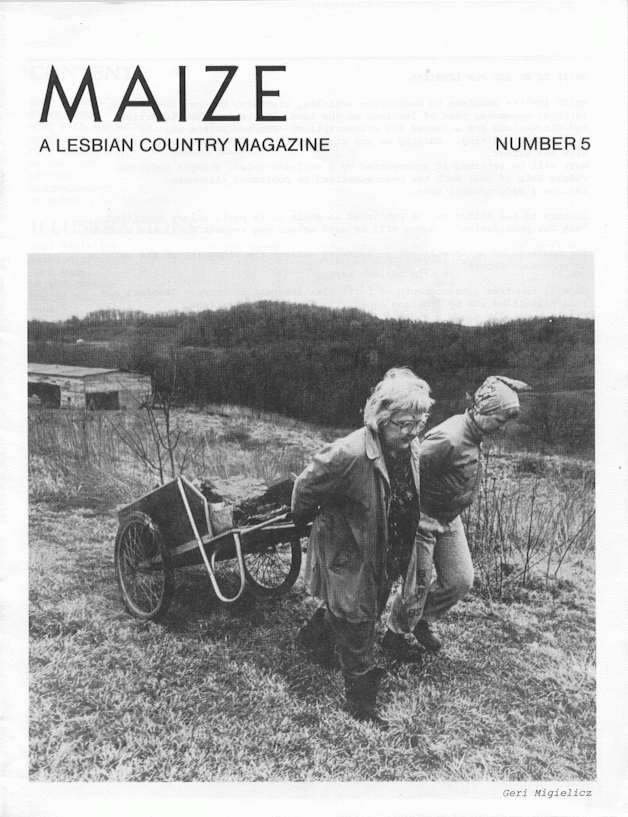
Maize, a Lesbian Country Magazine, published 1982-1997. Maize was originally published out of Preston Hollow, NY, then Minneapolis, MN and then Serafina, New Mexico.
There’s a lot to chew on with all this information, old and new — especially for me, as I’ve been tracking this particular mystery for six years and have been consistently surprised by the wildly disparate data available on the topic, both in terms of where LGBTQ women live and which places are most friendly to LGBTQ women. Most evaluations of LGBTQ geography lump men and women together, despite the fact that the two subcultures rarely overlap in practice, thus rendering themselves useless to lesbians. As we’ve documented, counting queer folks in general has been a challenge for the world, let alone nailing down those queer folks to particular geographical areas and drawing significant conclusions from that information. Even the Gallup poll that prompted last week’s conversation has a plus or minus 1% margin of sampling error at the 95% confidence level, which means the specific ranking of any particular city — as they’re all within one or two percentage points as the cities above and below them — isn’t readily apparent, just its general ranking. 2012 Gallup data about which states had the highest percentage of LGBTQ residents revealed that “the variation in the percentage of adults across U.S. states who identify themselves as LGBTQ is relatively small” and cautioned against drawing significant conclusions from the data, aside from the general conclusion that “states with proportionally larger LGBT populations generally have supportive LGBT legal climates.”
We’re apparently starved for this information, though, and won’t stop looking for it or trying to summon it. The Advocate does its own annual ranking of the most gay-friendly cities, using different criteria every time. Last year’s equation factored in LGBT elected officials, lesbian-coupled households, gay rodeos, gay bars, women’s colleges and “concerts by Mariah Carey, Pink, Lady Gaga and The Jonas Brothers.” The rankings often seem designed to produce controversial results — like in 2011, when Minneapolis, Santa Fe, Pittsburgh, Orlando and Las Vegas snagged the top five spots and New York and Los Angeles didn’t even rank.
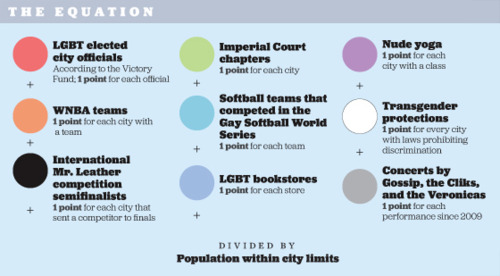
The Advocate’s 2012 criteria
In 2012, I took a crack at making a list of our own, entitled “The 21 Most Lesbianish Cities In The US,” looking at factors like our own reader location statistics from Google Analytics, Tegan & Sara concerts, LGBT-friendly colleges, LGBT or feminist bookstores, lesbian nightlife, inclusive ENDA policies, same-sex marriage legislation, and rankings from magazines like The Advocate and The Daily Beast. That year we also undertook the Queer Girl City Guides Project, where we solicited locals to tell the world about their homes and native lands. Despite the hordes of readers and writers we’ve got in Los Angeles, San Francisco and New York, those cities have been the hardest to find guide authors for — but we easily secured guides for cities like Spokane, Durham, Burlington, Pensacola, Madison, Columbia, Gainseville and Saratoga Springs. Our most popular City Guide is the one about Columbus, Ohio.
For the book There Goes the Gayborhood? by Amin Ghaziani, statistics ended up being only a small part of the research he drew on. He focused primarily on an analysis of 617 newspaper articles on the topic from all over the United Sates and by interviewing 125 gay and straight Chicago residents. This is a subject that requires looking at lots of data sets, lots of articles and drawing on lots of personal experiences to come up with anything like a comprehensive picture. So let’s do that.
The Numbers
First let’s look at the geographic data we have about all LGBT people, including the data released by Gallup last week. Here’s what they learned about the LGBTQ populations of the U.S.’s major metropolitan areas, compared to 2000 census data, and ranked in order of the percentage of the population in each area identifying as LGBTQ:
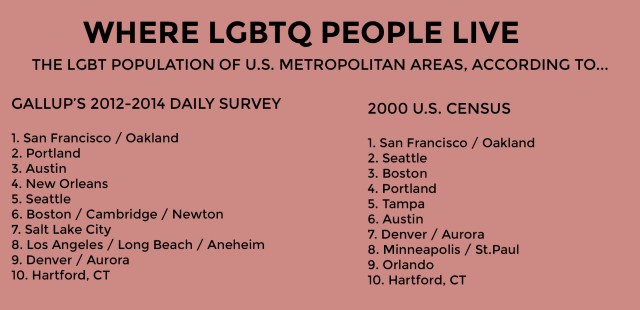
Unfortunately, there’s no breakdown of this data by gender. The best we can do in that department is to compare it to the data we have from our own readers, who are mostly queer women. In our 2014 Autostraddle reader survey, which had 3,455 respondents, we asked “if you live in the United States, which, if any, of the following cities is closest to you?” I then took that data and grouped together cities considered by the U.S. Census to be part of the same Metropolitan area to see how it compares to the data above.
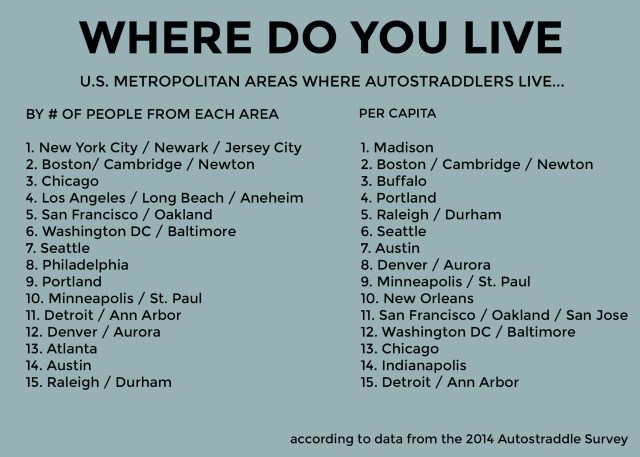
Of course, the 2014 Autostraddle Reader Survey has a lot of demographic specificities besides sexual orientation that could explain why we live where we live: like that the majority of survey-takers are between the ages of 18 and 34, 49% are single, 90% have been to college and 96% didn’t have kids. It’s not data that’d stand up in a research journal or paper, but it’s interesting nonetheless. Most importantly, perhaps, is the fact that these women are Autostraddle readers, which suggests an interest in queer community in general that not all queer people share. Our Google Analytics metro-area data reports traffic in this order: New York, Los Angeles, San Francisco / Oakland / San Jose, Chicago, Boston, Washington DC, Philadelphia, Seattle, Atlanta, Portland, Houston, Dallas, Minneapolis, Denver and, finally, Detroit.
On the other end of the demographic spectrum we have data that looks only at same-sex couples, as counted by the U.S Census. The “Lesbian Geographies” piece in Contexts (written by the author of There Goes the Gayborhood?) drew on Trulia’s analysis of 2010 U.S. Census Data, which revealed a market that “looks different for gay men and women, who often cluster in very different neighborhoods even in the same metro.” This chart has Trulia’s zip code analysis, as well as the straightforward by-city ranking directly from the census.
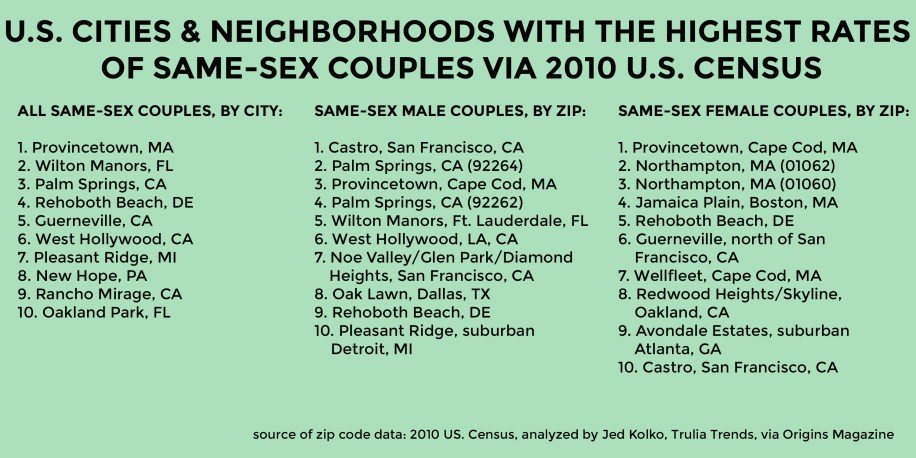
The New York Times looked at the zip code data set and determined its most surprising element was “how far same-sex couples have dispersed, moving from traditional enclaves and safe havens into farther-flung areas of the country.” They suggested that baby boomers were retiring and moving away from places like West Hollywood and San Francisco towards places like Pleasant Ridge, Michigan (population 2,569) and Rehoboth Beach, Delaware (population 1,398). But are these numbers really large enough to be meaningful? Trulia says Rehoboth Beach, for example, has a 2.4% share of same-sex female couples — with a population of 1,398, that means there are 33 lesbians in Rehoboth Beach. That’s not a lot of lesbians!
Here’s the first bit of information regarding “huh well, these numbers seem off” — Trulia says West Hollywood consists of 8.9% gay households. But West Hollywood did its own survey and found 41% of the WeHo population is gay and bisexual men and 5% of the population was lesbians and bisexual women. So — grain of salt.
So, two last sets of Autostraddle-related numbers: we asked the 6,058 United States residents who filled out our Lesbian Sex Survey two months ago (open to all women who had sex with women, and drawing on a more diverse population than the Reader Survey) what state they lived in, and when comparing the percentage of survey-takers who live in each state compared to the percentage of U.S. residents overall who live in each state, a few things stand out enough to be noted here. Lesbian sex survey-takers are…
- Slightly more likely than the general population to live in California, New York, Illinois or Washington
- Way more likely than the general population to live in Massachusetts or Oregon
- Slightly less likely than the general population to live in Florida, North Carolina, Georgia and Indiana
Finally, we have this infographic from The Williams Institute about where one might find the most same-sex couples raising children. This shows what percentage of the same-sex couples in each city reported that they are raising children under the age of 18. So, for example, 22% of same-sex couples in Detroit said they were raising children under the age of 18.
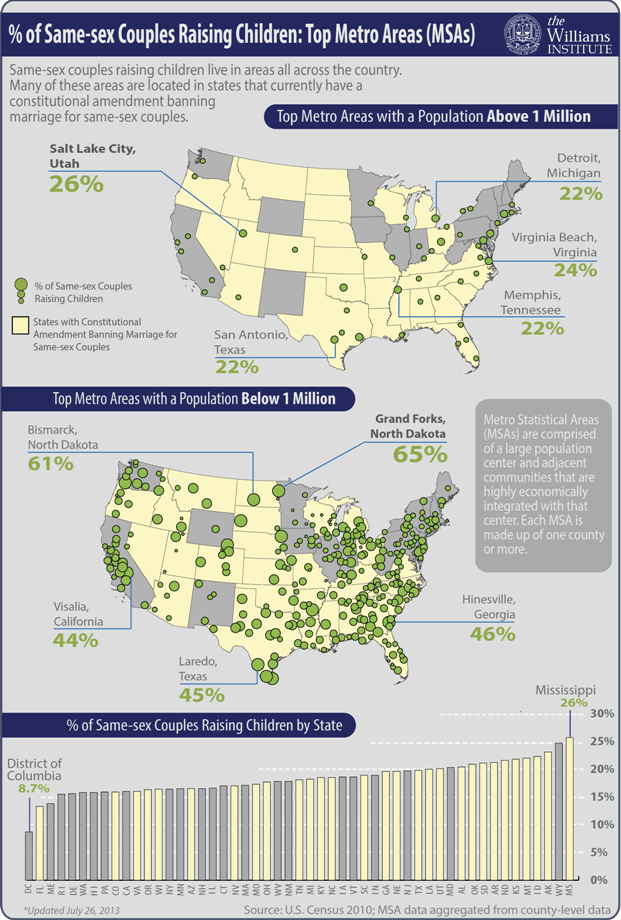
Because female same-sex couples are more likely to be raising children than male same-sex couples, it stands to reason that the cities highlighted above skew more lesbian than gay. Same-sex couple parents and their children are also more likely to be of color than different-sex couples, and the high rankings of cities like San Antonio (63.2% Hispanic/Latino), Detroit (83% black) and Memphis (62.6% black), could reflect that trend.
Beyond the Numbers
Let’s be real: a lot of these numbers are admittedly imprecise and many of them are just simply and obviously wrong! (This isn’t news to the statisticians and researchers, I should add — they recognize the limitations of their numbers, and the inherent challenges in surveying LGBTQ populations.) As I mentioned above, although the Census reported West Hollywood to be 8.9% queer, West Hollywood’s own demographers found its residents to be 41% queer men and 5% queer women. If their numbers about the East Bay were right, maybe there wouldn’t be such long lines at Ships in the Night.
The government only tracks co-habitating same-sex couples. Gallup only records people who are interested in revealing their sexual orientation or gender identity to a stranger on the phone. It’s hard to say if people who live in cities like Birmingham, Alabama, which landed squarely at the bottom of Gallup’s list of the most LGBT-occupied cities, are less likely to be LGBTQ or just less likely to say so. I mean, Birmingham scored a 9 out of 100 on the HRC’s Municipal Equality Index.
Plus, 6% of a neighborhood being gay does not a gayborhood make, regardless of how small a percentage of the population we are. Asian-Americans make up about 5% of the entire US population, but Mission Hills – Vineyards North in San Francisco, considered a top “Asian-American neighborhood,” is 74.6% Asian-American. LGBTQ people are between 3% and 10% of the population, depending on which survey you believe, and our #1 gayest neighborhood according to Gallup, The Castro, is just 6.2% LGBTQ. Have you been to The Castro? It is way more than 6.2% LGBTQ! Portland, the whitest large city in America, is 6.3% black. It’s considered the second-gayest city on Gallup’s list… and is supposedly 5.4% gay? Have you been to Portland?
At the very least, if LGBTQs comprise around 5% of the entire U.S. population, our numbers ought to hover around 5% in most places, and far exceed 5% in the areas where we allegedly gather. Pick up the local LGBTQ Weekly in any of the metro-areas listed above and you’ll see that with the amount of shit going on, there’s definitely more gay people in these areas than the Census or Gallup is uncovering. Although lesbians seem unable to support dedicated local lesbian bars, they’re flocking in droves to girls nights, local roller derby teams, lesbian softball leagues, organized “queer brunches,” pop-up queer barbershops and other spaces like readings, protests, The Planet and basketball games. “Lesbians like to hunker down and stay in,” a lesbian Chicago resident told Amin Ghaziani. “We like to stay on our patios, drink our beer, and have our barbecues. That’s why you don’t see us walking around… women have house parties or gatherings, or we would rather go out to dinner — but in small social settings. Not to say that women don’t go out to bars, but generally speaking, it takes a lot of effort to draw women out to bars.”
Furthermore, the overall demographic of LGBTQs doesn’t jive with the demographics of the areas where we allegedly live. LGBTQs are more likely to be of color, but the neighborhoods cited as gayborhoods are overwhelmingly white. Queer women and trans people are more likely to be poor, but the neighborhoods cited as gayborhoods are overwhelmingly rich. In There Goes the Gayborhood?, Ghaziani noted from his interviews with queer people of color, “The social and residential choices that people of color make resemble those of same-sex families. The outer ring, or the most general residential (and social) filter, is the ethnic community… Within this, many people of color seek a “queer safe space.”” Later in the book, Ghaziani (a gay man of color himself) says that, “in an act of exquisite agency, queer people of color are forming new gayborhoods of their own, rather than disappearing off our cultural map.”
These are just some of the reasons why, when it comes to gayborhoods, numbers from places like Gallup and the U.S. Census are important, but so are lived experiences, newspaper articles and random surveys of lesbians who read this website. Any information is useful information when the official information is so light on, well… information.
But looking at where they started can help us figure out where they’re going.
Gayborhoods: A Tiny History
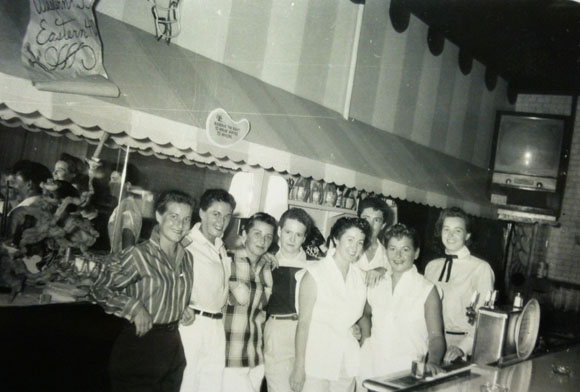
The Green Door on Lankershim Boulevard in North Hollywood, 1955. (via Remembering LA’s Earliest Lesbian Bars
Gayborhoods originally began to thrive after World War II, when a few things happened: gays and lesbians, newly exposed to a freer sexual society in Europe, opted to remain in military base cities rather than return to their hometowns. Gays and lesbians who’d been discharged for homosexual conduct moved into “self-protective” “refugee camps” (terms employed by activist Carl Wittman) in cities like Chicago, Seattle, San Francisco, San Diego, Philadelphia, New York, Miami and New Orleans.
The push for women to join the workforce during the war resulted in many queer women finally achieving financial independence from their home community but even moreso enabled those who’d been working in factories since their teen years to blend in. “In their minds,” write Kennedy and Davis in Boots of Leather, Slippers of Gold, “the important effect of the war was to give more independence to all women, thereby making lesbians more like other women and less easy to identify.” It became less unusual for women to have independent income, socialize in exclusively-female social groups, and walk home at all hours without a male companion. Industrial centers like Buffalo, New York, became hot spots for lesbians. In San Francisco, many gay women joined the Woman’s Army Corps, headquartered in the Presidio. Believe it or not, one patron recalls that in the ’50s, there were more lesbian bars than gay bars in the North Beach neighborhood of San Francisco because “fewer doors were open through normal channels (work, clubs, organizations) for women to meet other women of a like mind.”
Meanwhile, a thriving lesbian population had been building in Los Angeles since the turn of the century, as Hollywood was basically the only industry offering women an a way to get rich independent of her family. Businesses sprang up catering to these new populations, and after New York City’s Stonewall riots in 1969, the “great gay migration” (as it is described by anthropologist Kath Weston) of the 1970s and 1980s began, with gays and lesbians moving to cities in search of community just as those same cities were experiencing “white flight.” Justin Ocean wrote in The Advocate (as quoted in There Goes the Gayborhood?) that “the cycle of queer pioneers turning the dilapidated into destinations seems to be an intrinsic fact of gay life.”
Of course, by the late ’90s, people were already saying that gayborhoods were being overwhelmed by straights and facing an impending demise. “Gayborhoods long provided sexual minorities with a safe space in an often unsafe world,” writes Amin Ghaziani in There Goes The Gayborhood? “But now the world itself is becoming much safer.” There are so many reasons and theories for the overall decline of gayborhoods that we could talk about for days, but today we’re aiming to reach a conclusion about gendered geographies. So, to that end, it bears mentioning that if anybody’s sticking around in the “gayborhoods,” it’s gay men. They can afford it, they’re less likely to have kids, more likely to have the kind of extra income you need to enjoy an urban lifestyle and, as Ghaziani points out in “lesbian geographies,” “Gay men are more influenced by sexual transactions and building commercial institutions like bars, big night clubs, saunas, and trendy restaurants, while gay women are motivated by feminism and countercultures.” Furthermore, women are less able to own real estate and open businesses that’d mark the neighorhood as their own. In a Time Out Chicago April Fools’ article making fun of the lesbians who’d seen Chicago’s Girlstown evolve into a Boystown, moved to Andersonville, and now wanted to ensure Andersonville remained as girls’ town, the magazine quoted “out activist Pat Bushman” pointing out that “There are more than 25,000 dykes living on the North Side, and frankly, I’d like to see the city try and live without the $1,879 we spend annually on bars and nightlife.”
Sadly, the influx of moneyed residents has resulted in San Francisco becoming remarkably unfriendly to the queer and trans youth who once relied on its streets and services, a transformation already happening in New York, where development threatens the thriving community of homeless queer and trans youth who rely on the community found at the Christopher Street piers.
“San Francisco is a textbook example of what happens when gay people become part of the power structure,” writes Matilda Bernstein Sycamore in City of Brotherly Love. “They engineer the election of anti-poor pro-development candidates over and over and over again; they advise property owners on how to get rid of long-term tenants; they fight against the construction of a queer youth shelter because it might impact community property values; they arrest homeless queers for getting in the way of happy hour.” It’s unsurprising that these climates quickly edge out many lesbians as well as queers of color and trans people.
Ghaziani also points out that lesbians tend to move out of a male-dominated gayborhood because… well… men.
Do Queer Women Flock To Queer-Friendly Areas?
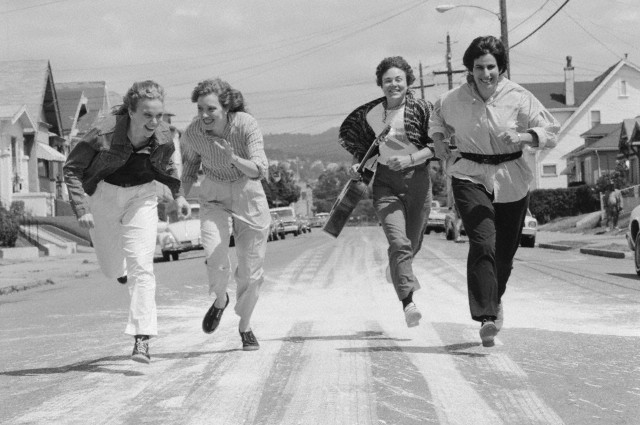
Oakland, California, 1976 (© Roger Ressmeyer/CORBIS)
Gallup says it did a survey in 2013 that found only 12% of LGBT adults “considered the levels of LGBT social acceptance in a city as a major factor in their decisions about where to live,” which struck me as wildly improbable. I don’t know any queer woman who doesn’t consider that element when deciding where to live — but maybe the fact that I’ve chosen to live in places like Ann Arbor, New York and the East Bay means that I’ll obviously know a lot of people who have considered that factor.
But a lot of queer women never considered that factor because they’ve never had a chance to choose where to live in the first place. You stay where you grew up, where your family is, where your job is. You stay somewhere because you can’t afford to move elsewhere.
We asked our readers about the gay-friendliness of their home in our Autostraddle Grown-Ups Survey, which garnered over 4,000 responses from readers 29 and up. The data revealed that either most of the world is gay-friendly, or a lot of you have migrated to gay-friendly places. 38% of you live in very LGBTQ-friendly areas, 27% in somewhat LGBTQ-friendly areas and 15% in legendarily LGBTQ-friendly areas (e.g., San Francisco, Chicago). Of those who didn’t report living in an LGBTQ-friendly area, 10% reported their area as “neutral” to LGBTQs, 2% weren’t sure, 7% reported a “somewhat hostile” environment. Only 1.47% of respondents said their area was “very hostile” and only .37% said it was unsafe to be “out” where they live. I imagine that many living in hostile areas didn’t make a “choice” to live there — it’s where they’re from, where their family is, where they could find a job or where they’ve always been.
The Municipal Equality Index, put together by the HRC, ranks 353 cities on their gay-friendliness — while acknowledging that the numbers can’t replace lived experience of the city’s friendliness. It is worth noting that a few areas considered gay meccas did not score that well — Ferndale, MI got a 57, while East Lansing scored 100. Miami, Florida got a 53, while Orlando scored 100. Still, the majority of cities with large gay populations scored high on the municipal equality index.
There’s a general sense of inevitable acceptance, though, that results in people like me deciding to move back to areas of the Midwest that presently lack legal protections. Even if things aren’t great now, the sense that things will change eventually might turn back the tides of lesbian migration. We’ve been forced to pay a hefty premium to live amongst our own and many of us are ready to settle down somewhere cheap as soon as it’s safe to do so. Although Gallup said that no Midwestern metropolitan areas showed up in its top ten, some of our most active Straddler Meet-Up Groups are in the Midwest: Cincinnati, Chicago and Minneapolis.
So, Where Do Lesbians Live?
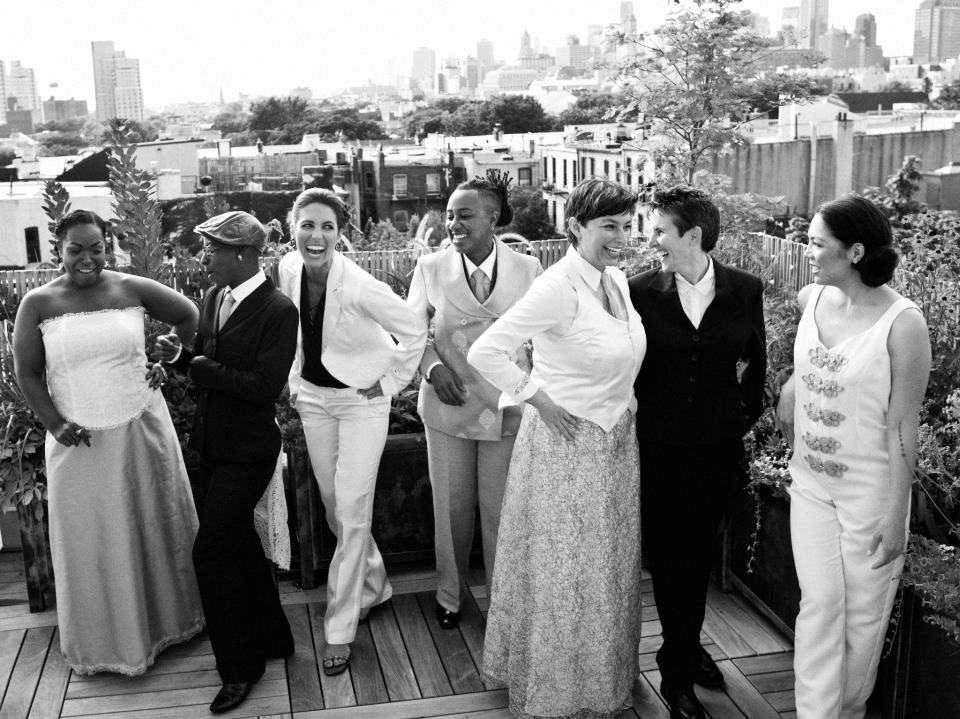
Lesbian wedding in New York with dresses made by Dangerous Mathematicians, photography by Parris Whittingham Studio, via wikipedia commons
The simple answer: everywhere. We often live in the same cities as gay men but can rarely afford the same neighborhoods, and we’re more likely to skip town to start families in more affordable areas with better public schools. Lesbian bars and women’s bookstores, once anchors of lesbian neighborhoods, are shuttering epidemically, but there are other social hubs for lesbians that continue thriving and reveal consistent trends in lesbian geography.
For example, lesbians are more likely to be involved in academia — as students or as professors — and to cluster on or near college campuses. Women’s colleges and other universities with strong queer communities are all over New England, which seems to host a disproportionately large lesbian population. Boston and Cambridge, specifically, have been lesbian enclaves for centuries — recall the “Boston Marriages” of the 19th century — and seem to remain so. A college town is likely to offer many of the cultural benefits of a city, including liberal politics, independent businesses and museums; but with lower rent, more green space, and good public schools for kids. Northampton (home of Smith College) has more lesbians per capita than any town or city in the country and is part of what’s made Western Massachusetts so damn queer. There are also high lesbian populations in college towns like Ann Arbor, Berkeley, Madison, Ithaca and Raleigh-Durham. Oakland is touted as having the highest lesbians per capita rate, and there’s a rich history in The East Bay — former Oakland residents include Gertrude Stein, Holly Near, Pat Parker, Angela Davis and Audre Lorde; and many of its buildings were designed by (allegedly) lesbian architect Julia Morgan. The North Oakland / South Berkeley area has long been lesbian territory, and is refreshingly racially diverse as well. But the tech boom in the city is pushing rents to unfathomably high rates, which is already trickling into the East Bay. It’s hard to know how long it’ll remain affordable for queers of color, young queer women, trans and non-binary folks.
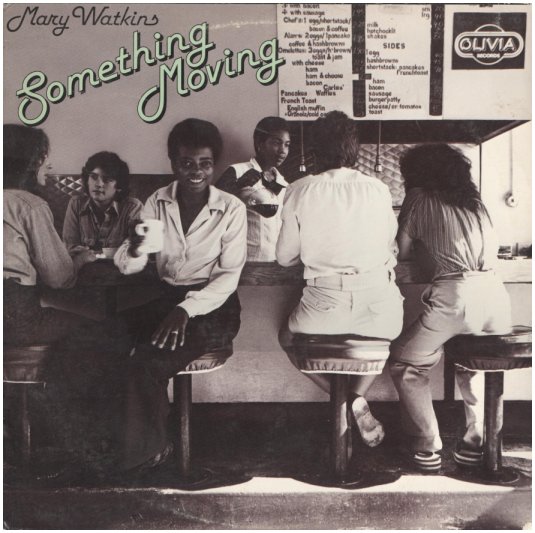
photo taken in The Brick Hut restaurant, a worker-owned feminist collective in Berkeley, via found sf
When we did the 21 Most Lesbianish Cities report, the comments lit up with queer women professing the greatness of their cities and proclaiming them the gayest city ever: Philadelphia, Albuquerque, Tuscon, Austin, Salt Lake City, Columbus, Miami, Houston, Burlington, Asheville, San Diego, Minneapolis… and on and on. There’s stuff happening, but a lot of it is just under the surface. “Lesbian neighborhoods… consist of clusters of homes located near countercultural institutions, like artsy theaters, bike shops, and cooperative grocery stores,” writes Ghaziani. “This gives them a quasi-underground character, and makes them seem more hidden.”
Does this mean we’ve all assimilated? Does it mean we don’t need lesbian neighborhoods anymore? Does it mean the men have kicked us out of the best places to be? Nope. But it does mean that now, if you’re in a position to decide where to live, you don’t have to pick between a place with lesbians or a place without lesbians, but rather can choose whether or not the lesbians you want to hang out with, work with, and run into at Whole Foods live there. There may not be many lesbian bars left for someone to walk into and find people like them, but you can still walk onto the internet and find people like you who live where you live, and then just pick a place to hang out in 3-D, and do so.
Final Thoughts
There are many limitations to the survey and research on this topic. It’s unclear if any transgender people were included in any of these counts or if the “T” was just slapped on to the acronym out of force of habit. There’s also no data on how racially diverse these LGBTQ populations are. Picking a place to live as a queer woman of color adds layers of anxiety to an already complicated decision-making process — not only must they wonder if the alleged gayborhood is primarily men, but also if it’s primarily white.
There’s definitely no data on the best places for trans women to live — we’re currently looking to rectify that, so if you have tips, please email our trans editor, Mey Rude, who is putting together that list. (mey [at] autostraddle [dot] com)
We’re also looking to put together a list of 21 Underrated Lesbianish Places To Live to draw attention to cities and towns with significant populations of queer women that aren’t often acknowledged as such. For this, we desperately need your input, and welcome it in the comments. We’re especially interested in towns and cities with thriving QTPOC populations and resources. So let us know!
So, I turn to you, queer women of this country: where do you live? Is it friendly to LGBTQ women? Does the gay-friendliness of a place influence your desire to live there? Are there misconceptions about the gayness of your town / city / village?


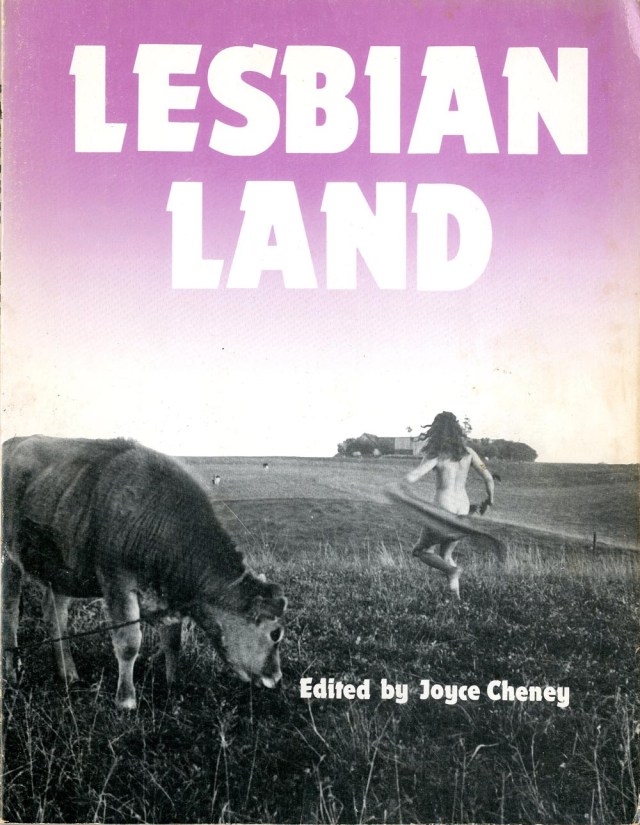

thank you for breaking all this down and for growing my brain like, three sizes today, riese.
agreed; this is a cool piece of research!
you’re both so very welcome! it only took like 60 hours nbd
For being #1 per capita, I feel like us Madison-straddlers could do a lot better organizing meet-ups and such. So I guess my question is–other Madison straddlers, where are you? And can we be friends??
I’ll be friends with you! We have a Madison straddlers group but yeah, it’s not very active. I think Madison can be a little cliquey. For having so many queer women, I don’t often meet people outside of my own friend group.
Is it a facebook group? Or a group on here?
I moved there from out of state (originally from Indiana) in Sept 2011 and have no idea how to make friends outside of work (and while my work friends are great, I’m still the only one I know who identifies anywhere in the alphabet-soup of LGBTQIAA).
Anyway! We should get a meet-up going :)
Hey! I’m in Madison, too! East side. I’m super involved in the gay community here and always happy to meet more queer people.
If a woman earns only 77% of what a man does, then a lesbian couple makes (0.77×2 =0.59) only 59% of what a gay male couple does. Could help explain why lesbian couples can’t afford SF but gay men can.
yup, that’s exactly why!
No, that’s bad math! A lesbian couple still makes 77% of what a gay male couple does. But the logic of lesbians having less disposable income and being priced out of SF holds.
yes you are exactly right! the fact that lesbians make less than gay men is the reason why we’re priced out of neighborhoods, i wasn’t commenting on the math!
I know you prefer using certain more googleable terms in titles and stuff but… not only is it super confusing how lesbian, queer and LGBTQ are used more or less interchangeably in this article but it’s also kinda offensive and illustrates the gap in research when it comes to bisexuality. Data on female same-sex couples does not equal data on lesbians, not all women who are in a relationship with a woman are lesbians? At the same time, it also doesn’t equal data on most queer women, since statistics suggest that a significant proportion of bisexual women who are currently in a relationship are in a relationship with a man (I think some studies put the figure as high as 80%).
It’s kinda shocking but also of course very revealing that the issue of where bisexual women specifically choose to live doesn’t really seem to come up at all in how people think about where “LGBT” people. I have a really hard time believe that “lesbian neighborhoods” don’t actually have a large number of bisexual women living within them & I want to see more thorough research looking at how bi women see themselves within “gayborhoods” and how they make decisions about where to live.
Yes, yes, yes, yes, this comment.
This is glorious. I agree with Carmen: my brain grew three sizes! Thank you for this; I know it took you like 300 hours.
I’m from Pensacola, and though I was not out when I lived there and was not involved in the LGBT scene, I’ve always been told it has one of the largest LGBT populations per capita in the US.
Every year on Memorial day weekend the beaches become a huge vacation spot for gays and lesbians, and, as far as I know, this is really welcomed by the community, and is a big boost for the economy (this was so well known that I thought that was true in every city).
Thank you so much for this article. This is something that’s been on my mind a lot recently, as a late-twenty-something single lesbian looking to make a big move from Long Island to a more heavily populated “underrated lesbianish place to live.” For the record, I’m considering NYC, Boston, Seattle, and Atlanta at the moment, mainly because I am finishing grad school in May and that is where some of my job prospects are, but also because I think there might be decent queer communities there. I look forward to reading future updates on this topic.
Thanks for the thoughtful work here!
I’m also surprised so few people consider how queer an area is when moving – I read this post specifically because I’m moving to either Palo Alto or Ann Arbor for law school (and just got back from visiting Durham) and I wanted to see if they were discussed.
you should move to ann arbor! that’s where i grew up, it’s super LGBTQ-friendly. palo alto is the most expensive place to live in the country right now, I think? which means it’s not that diverse. :-/ did you like durham? we were thinking about moving to asheville at some point in the far-away future.
Durham has a vibrant (if small-ish) queer scene; I’ve loved living here as a grad student. There’s even a monthly queer potluck group–an offshoot of an Autostraddle-inspired meet-up! Asheville, though, is a dream. I would live there in a heartbeat if I could.
I’ve been considering moving to Asheville for other reasons, but hadn’t heard that it was queer-friendly at all! This is exciting!
Admittedly, I have no idea what I’d do in Asheville for like, living and making money, but if it’s got both a vibrant paddling community (and awesome fucking rivers) and a vibrant queer community, it sounds like my dream come true and I should see if there’s a way I could actually live there.
I feel like I’ll really like Ann Arbor (visiting there and the Bay Area next week), but I might be too Southern to survive the winter. Palo Alto is insanely expensive but, you know, sun! Stanford! etc. I hate choices.
Durham didn’t do much for me, but I also happened to be there when I was sick and it was raining. My absolute favorite part of Duke was the queer law student group though, so that was definitely promising! I stopped in Asheville on the way up there, and it was really neat. I mean, they’ve got a place called the “aSHEville Museum.” Plus Western NC is kind of gorgeous.
Hi Andy, I grew up in the bay area. Palo Alto has nice weather, expensive shopping, and is a very wealthy and tech-centric area (aside from East Palo Alto, which is one of the most resource-poor areas in CA). It is a it isolated, i.e. not close enough to SF or Santa Cruz to make visiting those cities something that would regularly fit into a person’s life. San Jose is closer, but it’s not a great city to visit.
If you got into both Stanford and the University of Michigan (congratulations!), another thing I would consider is the difference in student population at private vs public schools.
Hey, thanks! I’m pretty heavily (like 99%) leaning toward Stanford after talking to more alumni. It’s a significantly smaller school (180 v 320 class size) and better for breaking into entertainment law. Again, the only turn-off is how dang expensive it is.
Hopefully I can find queers out there? I’m not completely sure how that population works out in Palo Alto.
This was really impressive! Thank you for this.
thank you for helping me sound smart about 95% confidence levels and sampling errors
tangent to your observation on academia, I whole-heartedly recommend attending graduate student seminars/events/etc if you live in a college town and are seeking queer friends. it’s become my favorite way to meet people now that I’m no longer a college student. Plus those events usually have free alcohol or at least a couple of fancy appetizers
excellent tip!
Maybe I should make a Debbie Downer ID badge/warning label for myself, but uh that’s not viable for some of us who can’t fit in with the class level of collegiates and academic types. Some college towns are made not made up of the same “quality” of people in those colleges.
*sad trombone*
While city is important on deciding where to move, I think we also need to look at the state as a whole. For example Miami(and Key West) is a great LGBTQ friendly area, but the rest of Florida is essentially a mess when it comes to our community, specially if you are trans/non-binary. Like bathroom laws that want to stop trans people from using the correct bathroom, or all the anti-gay laws Texas want to pass. Also, how much is same-sex marriage a factor in what city to live in?
I wonder what Canada would look like. We don’t have as many big cities to choose from though so probably just mostly Toronto/Montreal/Vancouver.
Riese, this was FASCINATING and so thoroughly researched, I’m very impressed, and very grateful you took the time to do this for all of us!
However, as a Canadian, it’s not all that useful to me personally. I wish there was a way to see a similar breakdown for Canada (though I think it’s a pretty safe assumption that the Canadian queers of all stripes are mostly concentrated in Montreal, Toronto, and Vancouver, but it would be nice to know WHERE in those cities the queers are concentrated).
Unfortunately, since our current federal government is allergic/politically opposed to objective science, data, and research, we are unlikely to get any of this information anytime soon. Without the mandatory long form census (which our government got rid of a few years ago, citing “privacy concerns”) so much valuable information about the demographics of our country has been lost.
I would also love to see the statistics (flawed as they would be) for Canada. Ottawa is the biggest city I’ve ever lived in Canada. I’ve moved around for grad school and internships but have never had the financial means to choose where I live based on welcoming neighbourhoods. However, I have found some pretty amazing (despite being small) queer communities living in small conservative towns.
I’m a Latina lesbian who has been living in Montrose, Houston, TX’s gayborhood for 8 years, and I’m currently saving up to move out for some of the reasons in your article. I don’t make a lot of money and the area is gentrifying rapidly, becoming richer, whiter, and straighter. I love my neighborhood and hate to distance myself from all the culture this area offers, not bars and universities specifically, but visual and performing art centers and communities. But living here means quickly escalating rent and having to move often as affordable housing is torn down, extremely over-priced, or falls into hazardous levels of disrepair. At some point, it becomes no longer worth it.
That seems to be a problem all over Houston. (I’ve been pricing out housing for a potential relocation for work.) It’s so bad ITL that I’m considering renting a house in…ugh…Sugar Land, since my office is there. Did I hear right that the Third Ward is starting to gentrify?
Third ward has started gentrification though it’s a ways away, the Heights is now as expensive as Montrose or more. Yes, Sugar Land is pretty sad but at least they have Japaneiros, a really good Latin Japanese fusion restaurant and Baps Mandir, a gorgeous handcarved marble Indian temple with an amazing buffet in the gift shop. There is a lot of great authentic Asian and Middle Eastern cuisine down south (though not in Sugar Land). I’m going up north to Greater Heights, so more north but still relatively close. A few years back a bunch of artists move to the East End so I was going to go there but it’s gentrifying super fast and developers are all about it.
Sigh. Houston. Good luck with the housing hunt.
I wish there was more data in general on this kind of thing, specifically smaller subgroups under the LGBTQ(etc) umbrella. The great Queer Internet Collective should smash all their computers together and get right on this. Autostraddle can’t do everything!
wow. I knew Northampton was gay, but I didn’t know it was THAT gay. It’s settled, I have to go to Smith now.
I went to college in North Adams, MA, so I hung out in Northampton all the time (even though it’s like an hour and 15 minutes away because you have to work for that nightlife in the Berkshires). Lesbian couples and young LGBTQs all over. Definitely an easy place to support gay-owned businesses. The bars and restaurants are great, as are the music venues. Great record stores and bookstores. Always interesting speakers and events because of the college. Surrounded by nature if that’s also your thing. And the nicest people ever. Oh, and they have their own Pride where you can spot Rachel Maddow if you’re lucky. So yeah. NoHo’s wicked gay!
Ohhh, happy days, I loved this! It’s clear that you spent a loooooot of time researching this, so thanks so much Riese <3
<3 <3
Articles about demographic shifts are apparently my favorite thing. SO. Kansas City, MO’s queer folks get overlooked a lot, which is understandable because I feel like we tend to be really integrated into the art and music scenes as opposed to Blatantly Queer Things. Plus for the longest time it was like pulling teeth to ever get anything organized here. (It probably still is. I got old and jaded and socially anxious and stopped trying. The cycle continues.) In addition to that, we have a weird urban vs exurban population divide that can be hard to reconcile. But it is getting better and the rent is still relatively super cheap and I get excited when new creative queer folks move here and decide to stick around for awhile. We need more.
And don’t even get me started on the QPOC situation here because that just starts with me shaking my head for 10 minutes straight.
That pointless screed was basically just to say that we midwestern queers do exist outside of Minneapolis and Chicago (Am I allowed to refer to Chicago as the midwest?), and it does get frustrating, and I really don’t want to have move to a coast to find a real live QPOC community some day. But I might have to. ugh
Wait, Kansas City has a queer community?! I live in Kansas City! We should meet up for coffee.
Chicago is DEFINITELY part of the midwest!
Great article, thanks for your hard work. I live in San Francisco with my family, but for a couple of years I lived in central Oklahoma, which is where I met a TON of lesbians and gay men. Maybe a reader who currently lives there knows more about this? Norman area, south a bit too, like Moore, Noble, even Lexington and Purcell.
Wait a tick… there are a lot of Autostraddlers in the Denver area? Really? I guess I hardly meet anyone due to my coursework up here in Boulder.
There’s a big meet-up group in Denver!
https://www.facebook.com/groups/552755394742340/
Boulder itself doesn’t seem to have as large an LGBTQIA population as you might think for being a college-town (I currently live in Boulder County). Many more live/work closer to Denver proper.
Speaking of meetups:
http://www.meetup.com/lesbian-connections/
I live in NYC… where I have lived for the past 16 years. Though it saddened me that this article seemed to leave NYC off the list for the most part, it also didn’t surprise me.
(BTW, for the past year I have lived in the formerly-very-lesbiany Park Slope, which, as your article validated, has become way, way less dykey — as in, notatalldykey — than many other areas [where I’ve lived] in NY… sad. I even recently popped into a “lesbian bar” called Ginger’s, and found only straight men.)
In a city as enormous and diverse as NY, it really blows my mind how undykey the Big Apple is. (I think that would be an interesting Autostraddle article — “Why Is New York City So Not Dykey”)
Thank you so much for this fascinating, thorough article.
Oh really? I felt like NYC was SUPER-dykey. I mean I guess that’s where I first realized I was gay, and maybe there was more going on back then? But it felt like a great place to be a queer woman.
I am so glad you wrote an article on this. This is such a thorough piece.
This piece is great – interesting, thorough, and thoughtful. Also very relevant to me as a resident-but-probably-not-for-too-much-longer-because-we-can’t-afford-it of Jamaica Plain in Boston. Thanks for doing this kind of work!
This was super interesting. And the deeper I got into the research you presented, the more it felt personally resonant. Practically all the queer women I know work in academia or nonprofit advocacy work or live in the suburbs because of the school district/life or some combination of the above. I live in a city neighborhood next to a gayborhood that is slowly being primed for gentrification. I’ve often wondered how to deal with the reality that gayborhoods almost always lead to gross gentrification and your piece gets me thinking about who really flocks to gayborhoods and what their agenda is. Mind blown.
This is so on point! My GF and I just moved from Oakland to Sacramento for all the reasons you stated and more. I am Mexican and from the central valley by way of SD and she is mixed and from the East Bay. As queers of color it’s easy to love Oakland but we eventually grew tired of daily burglaries and muggings and witnessed many of our favorite local spots being replaced with expensive trendy with like minded clientele. Ultimately the surge is rents combined with a desire to raise a family in a safe and diverse city led us to Sacramento. Time will tell how we adapt here but personally I feel that with age comes self awareness and my priorities have changed from needing to be surrounded by the queer validating stimulation of the city to the cultural familiarity of the Central Valley.
So you felt like the crime in Oakland is as bad as rumors say? I’m also queer POC and was considering Oakland as a place to move after I’m done with college. How are you liking life in Sacromento so far?
Awesome article! I learned like 100 new things.
Curious to learn more about this stat:
Is that for the US in general? If so, given that we’re about 70% white, that would mean that people of color are more than 1.3 times as likely to be LGBTQ than whites. Super interesting and cool!
Yes, it’s from gallup, that non-white individuals are more likely than white people to identify as LGBT!
gallup
colorlines
Brb moving to Oakland. Chicago is whatevs.
This is epic. When I had read several paragraphs and then noticed the scrollbar was miniscule and barely 10% of the way down I had minor palpitations at how much statistical wonder we were in for. Probably I need to do more cardio.
I commend and appreciate how much effort you put into bringing this to us!
Oakland has a few other factors besides history and proximity to SF that make it a lesbian / queer women / genderqueer town: Mills college and it’s a historically industrial / manufacturing / port city.
This was really impressive. Like, really.
Pieces like this make me proud to be an A-Plusser
<3 <3 <3
What a great piece with so much to dig into! I’ve never read coverage of this in such a thorough way. Love all the links to outside studies, articles, and writing! Also love the acknowledgement that income inequality creates a divide between communities of queer men and queer women.
I’m from the South Bay and went to college down south – moved back home afterward to try to re-launch as an adult in the Bay Area. Rapid gentrification makes SF itself impossible and at this point I’m hanging my hat on being able to move to the East Bay or somewhere south of SF with transit connections sometime in the next two years. It’s such a process every few months I feel discouraged, like I’ll never be able to afford the “quasi-urban with queer connections” green place in Northern California I crave. What with climate change making most of the state a dry spot maybe I should move even further north in CA? I just don’t know.
I feel like I’m going to need to reread this to soak all of the info in! Great stuff. Also, maybe we aren’t really that overlooked, but Minneapolis queers woo hoo! So many rad queer events have happened, are happening, and continue to pop up for the community to engage in. Twin Cities Autostraddlers host some of the best ones! (not at all biased here) ;)
I’m from Toronto, so I don’t know how relevant this will be. But, I lived in the Gay Village for 2 years with my partner. We found the area to be a little boring, ultimately. But we did spend 2 years surrounded by rainbows and other gay couples holding hands and grocery shopping with their children. Which was helpful for us at the time.
People here have been talking for years now about how the Village is disappearing. But so many of my queer friends have ended up moving there. They usually don’t stay long, only a year or two. But the fact that we seek it out to begin with is interesting.
Also, I find the idea that lesbians are flocking to the suburbs depressing. I love the city.
I love living in a big city… I’ve never seen myself as a suburban/rural type chick, but we’ll see when I’m older lol. And this whole thing made me either want to move to Oakland (I live in California already and was planning on moving up North anyway) or all the way to Massachusetts (much less realistic for me unfortunately). Very interesting read!
Before I was out, I spent years living in really, really liberal areas, like Seattle, having made the decision to move those places solely because in theory, I would be more comfortable being out there. But in the end, it wasn’t about where I lived. It was all about my headspace. I ended up coming out in the smaller, more ag-oriented city where I grew up, and realizing that there are communities of queer people everywhere, once you start to see them.
This is absolutely not shocking. I’ve always found myself living where more gay men are than women. I just prefer what those neighborhoods have to offer in terms of shops and curb appeal.
Boston is totally a queer paradise, but there are definitely differences between where gay men and lesbians live (this is grossly overlooking bisexuals :/). Yes, there are lots of queers, period, in Jamaica Plain (aka where couples go to settle down and grow a garden). Gay men set up shop in South Boston (which is also the location of the only remaining gay club in the city), and while I know of a fuckton of queer women in Somerville and Cambridge, there seems to be a lower concentration of gay men in those areas.
Also, it’s worth noting that Boston is one of the most racially segregated cities in the country. I’m a white Midwesterner who moved out here for grad school many moons ago, and I moved into and have since lived in already-gentrified or gentrifying neighborhoods. It would be interesting to (further) break the cities down by other demographics.
One reason I don’t want to move out of Somerville is because my favorite radically inclusive femme organization, Mad Femme Pride, is here. I love that I can walk a mile from my house for queer femme book club. I love that the book stores in the area stock the books we read. I love that I run into book club members at the grocery store. Feeling validated by this community, being able to participate and organize for this community, and being able to afford living here, is absolutely why I stay.
Same! I also live in Somerville and love the community. There are so many queers on my street alone! The bookstores! The coffeeshops! The food! I totally hear you. Also, I’ve been wanting to check out Mad Femme Pride. Why have I not done that yet.
Wow, what a great report. Thanks so much for this super-thorough research and writeup!
They spelled Anaheim wrong.
Normally it’s “Who may/will re-enter the house?”, “What will the have-nots eat?”.
I live in San Antonio and there is, surprisingly, a huge GLBTQ population here. Apparently, we have the highest number of same-sex families living here? (I can’t remember if it was in Texas or just the US.) I do see families all the time and I tend to bump into queer people everywhere I go. As far as neighborhoods, I’m not sure if there is a part where gay men or lesbians tend to reside… this might be because I live near UTSA. It’s a pretty mixed population.
Thanks for the informative article, I enjoyed reading it.
Can I just say, FTR, how much I really enjoyed the statistics for days? I love numbers, and what I loved most about these particular numbers was that (I’m a grad student in a really stats heavy group), just like when I am at work, you kept connecting it back to, “But does this statistically significant difference actually mean anything?” “What does this mean in the grand scheme of things?” etc. Happiest heart, I really loved this piece.
Just as a note- Pleasant Ridge’s tiny population is deceiving. It’s an itsy bitsy, two-policemen, half-a-square-mile strip of a city, just north of Ferndale (gay mayor, large LGBTQ population), and is pretty much just a fancier, more expensive Ferndale with a pool that they won’t let us use. :)
I love the article as I sit in motel room in Lee CT taking a break from hiking the Appalacian Trail. Love the feel of western mass, and I probably need to move away from NYC soon. Even though I went dizzy with the different ways to look at the data to figure out “how queer is this place, I yearned for a certain piece of information that I don’t think was in the article.
In NY, ratings of lesbian and similar places often warn of a place being full of old ladies – eg over 35! Well, I’m turning 60 this year and I only came out a few years ago. And I want to put myself in a place with a high chance of being the answer to someone’s dreams and vice versa (or at the very least find someone who’d like to put her hand under my shirt…) So I know Northamton is the Big L Mecca; but what about age spread? Is a sixty year old femme baby dyke out of place?
I happen to have no plans tonight, so I am going to go into NHampton to do field research! But one night poking around bookstores isn’t likely to get the real story. If anyone can share that kind of info sometime, very cool. Yes, I know Autostraddle is for a New Generation of lesbians – just because I’ve been around this many decades doesn’t exclude me AFAIC.
So if you see a femme gal who looks mid-40’s walking around in her CBST synagogue tshirt in NHampton tonight, that will be me. Feel free to stop me and clue me in.
Thanks for a wonderful magazine. It’s been a lifeline for me.
love Rivke
Thank you for bringing those issues to the forefront. My head is swimming in statistics, but well presented.
Isn’t “Pride” & “Family” supposed to include Lesbian and transgender? Of the evermore popular LGBT acronym, half of the letters are looking elsewhere to get some recognition. What does it say about our movement when lesbians and transgender individuals need separate or additional events to feel visible?
Lesbians are still struggling to get attention in the LGBT rights movement. Flip through the next gay magazine that you find and take a look at the advertisements. Most of them will feature and target gay men because the writers and advertisers assume that, just like straight women, lesbians will have a higher tolerance for being left out and still remain interested and active.
Many of us in our own gay communities have lost focus, forgotten the true struggle that those (lesbian, trans, bi, queer, etc) before us endured.
We need not forget that we relied upon the support of each other.